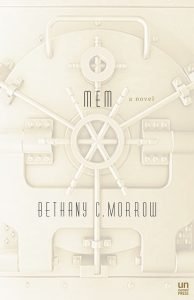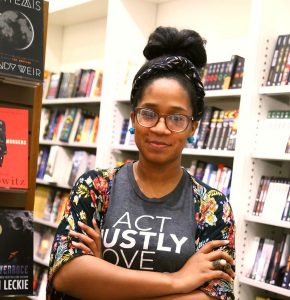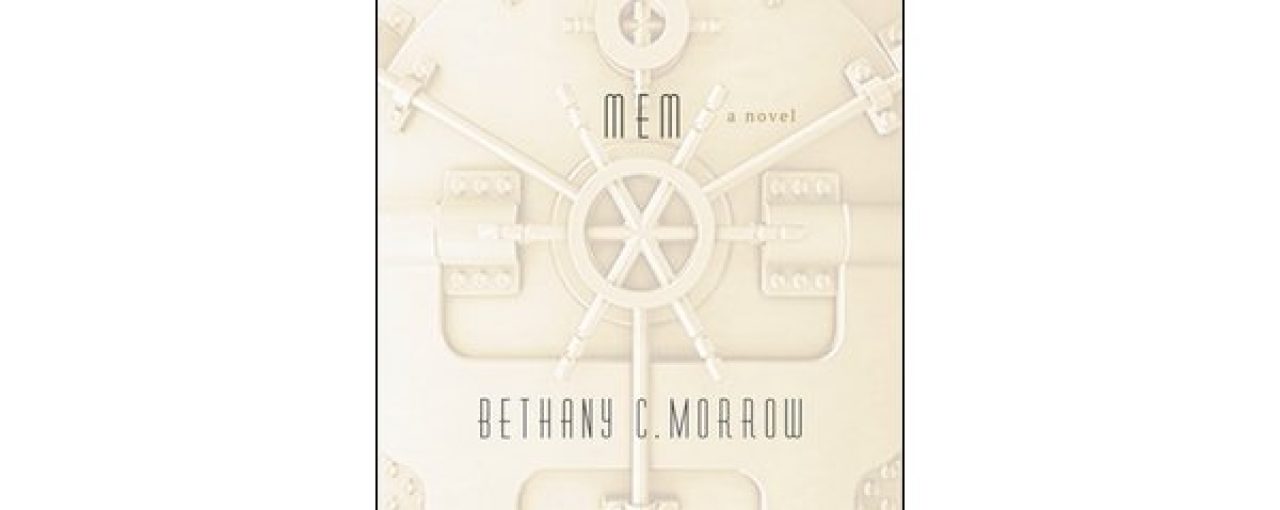A Look at Indie Authors and Their Publishers
By Lanie Tankard, Indie Book Reviews Editor
MEM: A NOVEL by Bethany C. Morrow (Unnamed Press, May 22, 2018). 192 pp, hardcover, $25.00. Also available as e-book and audiobook.
“Better by far you should forget and smile
Than that you should remember and be sad.”
Christina Rossetti
“Remember”
 Who owns our memories?
Who owns our memories?
In her provocative debut novel, MEM, Bethany C. Morrow employs both a scientific and a literary lens to contemplate this question. Her plot is grounded on the idea that doctors can extract a memory from a Source and put it into a mirror-image surrogate called a Mem. Sources retain ownership of their Mems by law in Morrow’s setting of 1920s Montreal. The cloned Mems, stored in a hospital-like Vault, keep reliving the same memory but eventually expire.
Until, that is, scientists realize that Delores Extract No. 1, Morrow’s protagonist, is a resilient anomaly capable of creating her own memories and would like to be called “Elsie.” Because she’s “the only cognizant Mem to date,” she’s allowed to live for a while outside the Vault with Professor Toutant (“the father of extraction science”) and his wife, Camille. Elsie moves freely in the world for a time, until she’s recalled to the Vault—where she falls in love.
Elsie, a black Mem, becomes a metaphor representing race, chattel slavery, attitudes toward women, female scientists, and involuntary servitude. Morrow alludes to the economic barrier for owning Mems as well. Only Sources who can afford Mems can acquire them, making the Mems expensive bling borrowed from the Vault to show off at cocktail parties—akin to jewelry stored in a bank’s safe-deposit box. One Dowager in the beginning stages of dementia wants three happy memories (referred to as “Keepsakes”) extracted as a creative inheritance for her children. Morrow touches on the Nature versus Nurture debate when Elsie suggests to the Professor that attention has been focused on only the nature of memories while overlooking “how the Vault shapes them.”
What, exactly, is “memory”? According to Plato in Theaetetus, Socrates called memory a gift of Mnemosyne, Greek goddess of memory and mother of the Muses, saying: “…whatever is imprinted we remember and know as long as its image lasts, but whatever is rubbed out or cannot be imprinted we forget and do not know.”
Centuries later, Nobel laureate Daniel Kahneman, a Princeton psychologist, spoke of “our remembering selves” and our “experiencing selves” in a 2010 TED Talk, underscoring the idea that each of those selves comprehends happiness differently. In his book Thinking, Fast and Slow, Kahneman wrote: “My impression is that the elimination of memories greatly reduces the value of the experience” (p. 441). Another psychology researcher, Daniel Gilbert of Harvard, discussed the science of happiness in a 2004 TED Talk, noting in a later article: “…we’re not supposed to be happy all the time” and adding “[h]appiness is a noun, so we think it’s something we can own. But happiness is a place to visit, not a place to live.”
Yet memory extraction is not science fiction or fantasy any longer. It’s getting closer to reality. Some researchers hope it could be useful in cases of PTSD or extreme fear. Others, however, question whether we should erase memories if we could, citing the “Law of Unintended Consequences” and cautioning that self-concepts might be affected. Neuroscientist David Eagleman of Stanford University has wondered whether the process of memory extraction would even be ethical if it actually became possible.

Morrow’s thought-provoking novel approaches a literary meditation on scientific integrity applicable to current issues. Who actually owns all the memories we willingly share on social media today that activate bombardments of targeted advertising? Morrow’s plot moves into a mass repossession of memories, delving into the morality of reprinting them and the legality that emerges from court rulings in the book. She’s created a compelling scenario that explores the outer limits of being human, reminiscent of Kazuo Ishiguro’s Never Let Me Go and Charlie Kaufman’s Eternal Sunshine of the Spotless Mind. Daniel Keyes explored parallel themes about treatment of the mentally disabled using surgical techniques to increase intelligence in Flowers for Algernon, an award-winning short story he enlarged into a novel of the same name (later a movie titled Charly).
MEM brings up all kinds of questions. How would the identity of a Source change once a particular memory was gone? Does a Source end up with “a fractured or fragmented mind,” stuck in rehab? What about the brains of the Mems? Delores Extract No. 1 will fire up your synapses. Readers will cheer her on to the end, not anticipating what the author has in store.
Bethany C. Morrow packed a lot of ideas into her brief allegorical novel, setting it in the past yet commenting on the present. Greek writer Flavius Philostratus wrote of Apollonios, who chanted a hymn addressing Mnemosyne: “…everything is worn and withered away by time, whereas time itself never ages, but remains immortal because of memory.”
Bethany C. Morrow is a speculative literary fiction writer. She holds a degree in sociology from the University of California, Santa Cruz, and studied clinical psychological research at the University of Wales, Bangor, in Great Britain. MEM is her debut novel. Morrow lived in Montreal, where MEM is set, for six years. She has a blog called “Expatriate Games.” Her debut YA fantasy novel, The Sound & the Stone, is due out from Tor Teen in Winter 2020.
Publisher: Unnamed Press
 Five-year-old Unnamed Press is part of the West Coast publishing scene. It’s named for all the undiscovered literary voices out there—those authors who get passed over by the larger publishers. Founded in 2013 by C.P. Heiser and Olivia Taylor Smith, this indie press publishes contemporary literature from around the world, and has expanded to nonfiction and YA fiction.
Five-year-old Unnamed Press is part of the West Coast publishing scene. It’s named for all the undiscovered literary voices out there—those authors who get passed over by the larger publishers. Founded in 2013 by C.P. Heiser and Olivia Taylor Smith, this indie press publishes contemporary literature from around the world, and has expanded to nonfiction and YA fiction.
Heiser, current publisher and editor at Unnamed Press, is also executive director of Phoneme Media, Unnamed’s sister nonprofit promoting cross-cultural understanding through translated books and films. He has worked in New York City at Wiley and at The New Press. Smith, Unnamed’s executive editor, translated the French graphic novel Panthers in the Hole into English for Phoneme. Both Heiser and Smith helped start the Los Angeles Review of Books (LARB), where he was an editor and she was publishing director.
Unnamed Press has grown from three books in 2014 to fifteen titles last year, distributed by Publishers Group West. Submission guidelines are on the website.
Copyright 2018 Woven Tale Press LLC. All Rights Reserved.

